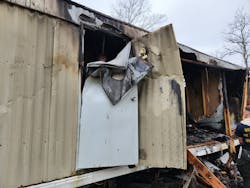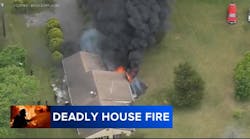For every run that we respond to, we must expect fire and victims. Always. The fact is that in most cases, fortunately, there are no trapped victims, and the fire usually is knocked down with one hoseline. That’s what the statistics tell us. However, regardless of the stats, because the caller said “fire” (and in this case, “victims trapped”), our preparedness and response must be as though there will be a fire and there will be victims until we, the fire department, determine otherwise. We must arrive quickly and expect the worst-case scenario, with proper, well-trained staffing and a plan on how we’ll fix the problem. Sometimes while we do that, our plan goes awry. That’s when training—and more training—along with experience pays off for the victims and the firefighters. That’s exactly what happened in Goshen Township, OH, on Feb. 28, 2023.
Our thanks to Goshen Township Fire & EMS (GTF&E) Chief Edward Myers, Division Chief Kevin Lynch, Division Chief Jake Rose, Capt. Cody Martin, Capt. Robert Rose, Firefighter/Paramedic Ian Smith, Firefighter Reid Daniel, Firefighter Emilie Ziese and all of the members of GTF&E and the crew members of their mutual aid partners for the the assistance that they provided regarding the details of this incident.
Dwelling fire, occupants trapped
A dwelling fire was dispatched at 11:56 a.m. by the Clermont County Communications Center. The initial dispatch was a fire with entrapment.
On arrival, a victim who had severe burns was on the front porch of the residence, and two others were reported to still be inside: The burn victim’s wife was blind, and her sister had vision problems, too.
The first-alarm assignment consisted of GTF&E Engine 18, Engine 19 and Medic 19; Incident Management Assistance Team 18; Miami Township Fire and EMS (MTF/EMS) Quint 26; Stonelick Township Fire Department (STFD) Engine 40; and Loveland-Symmes Fire Department (LSFD) Medic 63. Air Care was placed on standby based on dispatch information.
The fire was in a 50-year-old, single-wide mobile home that had three bedrooms and two baths that was in a hydranted area. Crews were familiar with the location and the occupants because of frequent EMS details at this residence.
Rose arrived with heavy fire and smoke from the Alpha side. He confirmed that there still was entrapment, with a third person still missing. During his initial 360 size-up, the third occupant exited the structure without anyone seeing her. Soon after, Lynch arrived and assumed command.
E19’s crew was Daniel and Martin. Rose was at the front door assisting with the stretch. They were making a push toward the fire in the rear of the mobile home when an explosion occurred. The explosion (which was learned to have been from an oxygen tank) blew out the exterior wall and blew debris down the hallway that hit all of the crew members. Martin advised Daniel to keep flowing water and to make his way down the hallway to the room of origin.
E18’s crew tended to the three occupants of the structure. The male patient on the front porch was in his 60s and had full thickness burns to 40 percent of his body and partial thickness burns to 9 percent of his body, with severe airway burns. (Unfortunately, the victim died a few days later from the burns.)Account from Myers
I backed in at an angle to the Alpha side of the structure in a lot across the street. When starting to document the incident and to read the smoke conditions, the explosion happened, blowing fire about 20 feet out of the rear bedroom window. I immediately called for a CAN (Conditions, Actions, Needs) report from E19. They were OK and making a push with no needs. I radioed dispatch that we had an explosion and asked for two additional engine companies and two more ambulances.
MTF/EMS Quint 26 pulled a handline off of E19, and apparatus operators were establishing water supply. STFD Engine 40
assisted with the primary search. LSFD Medic 63 assessed the additional victims, and Wayne Township Fire/EMS Medic 55 was requested to standby on scene. Milford Community Fire Department Engine 71 was diverted from the scene to the designated landing zone to land UC Health Air Care.
There were no obvious indicators that there was going to be an explosion before it occurred. I was thankful that the crew was wearing all of their PPE and that Martin made sure that they flowed water before—and after—the explosion. All members remained calm. There’s no doubt that training and experience played a big role in the outcome of this incident.
Rose, Firefighter/Paramedic Dustin Engled and Firefighter/Paramedic Nick Messer responded to the scene from a training detail. Rose was sent to assist with the primary and secondary search, and Engled and Messer assisted MTF/EMS Medic 28 with the care and transport of the burn victim to the landing zone.
Account from Robert Rose
On arrival, I had heavy smoke crossing the roadway. The police department was on scene, and one of the officers was running toward the front porch. I also noticed the people on the front porch, and I got a 360 of the building. I had no fire showing. The front door was open, with gray smoke pushing out. I established command.
The two victims were on the porch, so I exited my vehicle (not geared) and went to remove them from the porch, but the burn victim was unable to stand. I advised the police department not to break out the front window, which one of the officers was about to do.
With the primary line in play at the Bravo side, smoke had taken over the entire doorway. I advised the crew that the third victim most likely was in the bedroom toward the Alpha side. We now had heavy fire inside and outside of the building. I hadn’t passed command to Lynch and was geared up to assist.
Among the primary crew, Reid was located in the kitchen approximately 20 feet in, flowing and moving. Martin was 10 feet behind him. I had entered to assist and was just past the threshold of the door. This is when the large explosion erupted inside of the building, blowing the windows out of the building and blowing off my helmet and shelving from the walls, the latter hitting Martin on his SCBA.Account from Martin
When we made our interior attack, we faced heavy smoke conditions immediately on entry. I knew that we possibly had someone trapped, so my priority along with the fire attack was to find the missing occupant.
Conditions were heavy smoke, moderate heat, with no visibility. Daniel and I kept pushing to the Charlie side toward the seat of the fire. Quite a bit of furniture was in our path, which made it difficult to maneuver. I kept showing Daniel my thermal imager screen to show him where we were going and the location of the fire.
When the explosion occurred, Daniel and I were making our way to the rear bedroom for fire attack. We were in the kitchen, just down the hall. Because of limited visibility, there wasn’t much of a change in conditions from our perspective. We were met with the force from the explosion. As well as being hit by the drywall, the ceiling fell down on us.
My first thought as the company officer was to make sure that my crew was OK. I checked with Daniel, and he was OK. I made voice contact with Rose at the front door, and he advised that he was OK. I confirmed with him that we were OK.
Command immediately asked me for a CAN report and also advised that there still was heavy fire on the Charlie side. Daniel and I kept pushing into the hallway, where we made a good knock down of the fire.
After the explosion, heat and visibility conditions immediately improved, because the Charlie side basically was completely blown out, which permitted the venting of the smoke and heat.
After I saw the extent of the damage, I was in shock at how violent the explosion really was. I’m glad that the interior crew was located where we were at the time of the event. There definitely was the potential for injuries or worse had we been closer.
Account from Lynch
I was the second unit on scene and arrived seconds after Rose. I was the first-arriving chief and had a brief face-to-face with Rose. He got dressed and went to complete a 360. I assumed command. I advised the first-arriving engine company that we had a hydrant right next to my vehicle.
Within moments, Myers arrived and assumed command, so I got dressed and took Alpha division. (In our region, command normally remains in the buggy and Alpha coordinates operations.) As I dressed, a loud explosion occurred. I was looking down the Charlie side. The wall was bowed out from the explosion. The rear door was bent in half over itself and had heavy fire coming from Charlie.
At the moment of the explosion, I thought I just witnessed the engine company getting injured or being killed.
Comments from Goldfeder
Thanks to some very focused and enthusiastic officers, this region is very dedicated to training, and members literally live the Gordon Graham mantra of “Every day is a training day.” In fact, even when the dispatch for this incident came in, members of the GTF&E were training.
Immediate focus was on rescue. To do this, a heavy first-alarm assignment is required, so numerous tasks can be performed as close to “simultaneously” as possible.
First-alarm assignments should be developed on the assumption that the run will be a working fire with occupants. This first alarm brought 20 firefighters/officers and chiefs in addition to the other companies that were special called.
See fire? Flow water. It’s been proven time and time again that “smoke is fire” and that reduction of heat is what’s best for occupants and those who search for them. In this case, water was flowing before, during and after the oxygen tank explosion, which helped to reduce conditions.
Police on scene. As well-meaning as law enforcement might be, they can lack the understanding that opening doors and taking out windows can make conditions worse. I strongly recommend that all fire service leaders ensure that their local law enforcement personnel take the no-cost “Safe Law Enforcement Operations on the Fireground” online training from the International Society of Fire Service Instructors.
Training and more training. The scenario of searching for victims as an emergency occurs has been practiced by GTF&E and their mutual aid partners repeatedly. Although certainly concerning when the explosion occurred, everyone who was on the fireground reverted to their training, which resulted in a calm response, maintaining water flowing and immediate accountability by command.
Of note: When Rose arrived, he immediately (and appropriately) left his vehicle to remove two burned victims from the doorway. After that, he went back to his vehicle and geared up.
In a discussion with him about the incident, he said, “I realize now looking back that I had not updated—as I was initially command—that we had a possible third victim entrapped and that we had two people outside on the Alpha side” and “during my gearing up process, I forgot my radio and didn’t use my helmet strap.” While his focus was for the victims, these are good lessons and reminders for us all.








